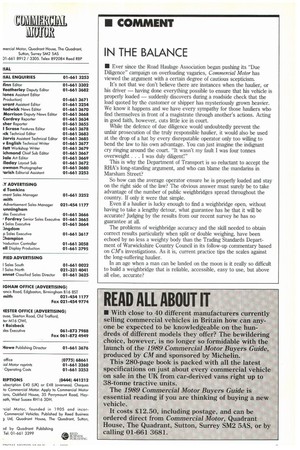IN THE BALANCE
Page 3

If you've noticed an error in this article please click here to report it so we can fix it.
• Ever since the Road Haulage Association began pushing its "Due Diligence" campaign on overloading vagaries, Commercial Motor has viewed the argument with a certain degree of cautious scepticism.
It's not that we don't believe there are instances when the haulier, or his driver — having done everything possible to ensure that his vehicle is properly loaded — suddenly discovers during a roadside check that the load quoted by the customer or shipper has mysteriously grown heavier. We know it happens and we have every sympathy for those hauliers who find themselves in front of a magistrate through another's actions. Acting in good faith, however, cuts little ice in court.
While the defence of due diligence would undoubtedly prevent the unfair prosecution of the truly responsible haulier, it would also be used at the drop of a hat by every disreputable operator only too willing to bend the law to his own advantage. You can just imagine the indignant cry ringing around the court. "It wasn't my fault I was four tonnes ovenveight . . I was duly diligent!"
This is why the Department of Transport is so reluctant to accept the RHA's long-standing argument, and who can blame the mandarins in Marsham Street?
So how can the average operator ensure he is properly loaded and stay on the right side of the law? The obvious answer must surely be to take advantage of the number of public weighbridges spread throughout the country. If only it were that simple.
Even if a haulier is lucky enough to find a weighbridge open, without having to take a lengthy detour, what guarantee has he that it will be accurate? Judging by the results from our recent survey he has no guarantee at all.
The problems of weighbridge accuracy and the skill needed to obtain correct results particularly when split or double weighing, have been echoed by no less a weighty body than the Trading Standards Department of Warwickshire Country Council in its follow-up commentary based on CM's investigations. As it is, current practice tips the scales against the long-suffering haulier.
In an age when a man can be landed on the moon is it really so difficult to build a weighbridge that is reliable, accessible, easy to use, but above all else, accurate?


























































